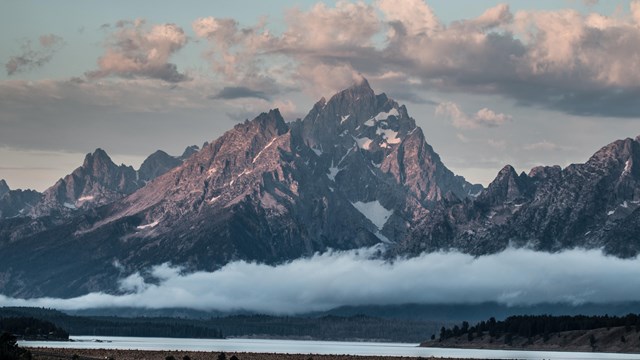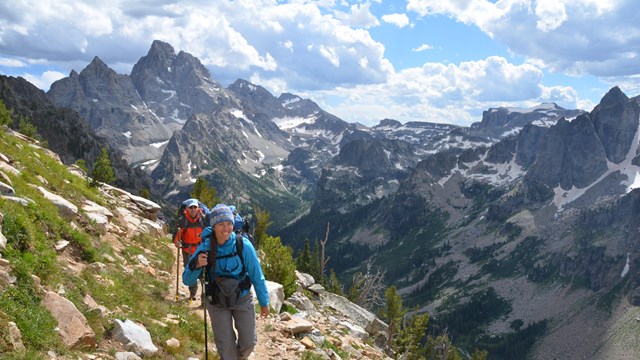
NPS Photo About Grand Teton TerrainHigh alpine conditionsYou'll travel through many ecosystems and communities on your trip though the backcountry. As you climb out of the sagebrush valley and forested morains you'll find yourself in an high apline environement. Here, there will be beautiful alpine flowers, snow, and little shade. Hiking in the alpine is beautiful, but requires planning to find water and avoid sunburn. Drinking Water AccessStreams flow through every canyon. Alpine lakes dot the high country. Water is plentiful and easily accessed in the Grand Teton backcountry. In late summer, the following areas may become dry: Fox Creek Pass, Death Canyon Shelf, Mt. Hunt Divide, and Open Canyon. Bear CountryBlack and grizzly bears live throughout the park. Some of the most popular trails travel through excellent bear habitat and it is alway possible to encounter a bear when hiking. Grand Teton National Park requires the use of Interagency Grizzly Bear Committee approved containers for food storage in the backcountry. Permit holders may check out a canister with their permit, free of charge. Backpackers are welcome to bring their own bear-resistant food container. For a list of all approved portable bear-resistant food containers please visit the IGBC website. All food, garbage, toiletries and any odorous item that may attract a bear, must be stored in a bear-resistant food container when not in immediate use, day and night. Prepare food, eat, and store your food container at least 100 yards downwind from your tent. Store your container and clean cooking gear on the ground, hidden in brush or behind rocks. Do not place canister near a cliff or water source. Hanging food inside park boundaries is strictly prohibited. On some specific alpine routes where a climber is bivouacking on a high rocky ledge where bears cannot go, park-approved bear canisters may not be required (check with a ranger). Learn More:
You many encounter...
NPS Photo Snow into JulyPaintbrush Divide, Hurricane Pass, and Static Peak Divide, among others, remain snowy and hazardous well into the summer months. An ice-axe, crampons, and the ability to self-arrest are musts. Assess your group's comfort with risk. Ensure everyone is confident in the requisite skills before committing to an itinerary that involves traversing these areas. The popular Paintbrush/Cascade loop and Teton Crest Trail are two such routes that demand these skills. Snow covered trails make for inefficient and unpleasant travel. The freeze/thaw of late spring and early summer creates rotten snow. Snowshoes and other flotation devices lose effectiveness. Post-holing in knee-to-waist-deep snow is likely. The weight of a heavy pack adds to the difficulty. Under a blanket of snow, trail-finding is tricky and time-consuming. Plan to cover less distance than what you are accustomed to when hiking on snow-free trails. Do not trust that the tracks or boot-pack from previous hikers is the correct or safest route. Experienced backpackers are often caught off-guard by the challenges presented this time of year. Many find hiking in these conditions unpleasant and abandon their trip. Lack of connectivityCell phone coverage in Grand Teton backcountry is spotty and unpredictable. Consider carrying a satellite communication device. HypothermiaHypothermia can be life-threatening. The wetting effect of an unexpected storm, combined with the cool temperatures of Grand Teton’s high-country, can make backpackers susceptible to hypothermia. Signs of hypothermia include uncontrollable shivering, incoherent speech, and exhaustion. Seek shelter, replace wet clothing, and provide warm liquids. In serious cases, place the undressed victim in a sleeping bag with another undressed person. Carry rain gear and extra clothing. Dress in layers and avoid wearing cotton. LightningAfternoon thunderstorms are common in the Tetons. Avoid exposed summits and ridges, open areas, lone trees, and bodies of water. Forested areas with trees of similar height are safer. Do not stand on tree roots. Altitude SicknessElevations in the park vary from 6,320 to 13,770 feet above sea level. Altitude sickness may strike anyone. Symptoms include headache, nausea, sleeping difficulties, and tiredness. Ascend trails slowly. Treat mild altitude sickness with rest and fluids. If conditions persist or worsen, descend to a lower elevation. DehydrationThe high elevation and low humidity of the Teton Ranger can drain your body of fluids. Drink water before your hike, carry plenty of water, and continue to hydrate after your hike.
More on Backcountry Camping
Weather
Learn about the weather and climate of Grand Teton National Park. 
Backcountry Camping
Plan your backcountry adventure. 
Backcountry Zones and Sites
Map out your route and find a place to camp. |
Last updated: July 17, 2025

